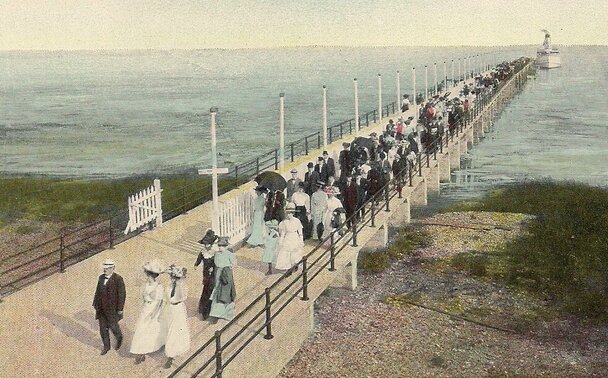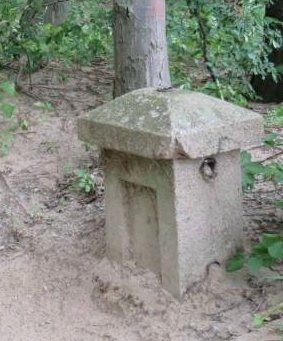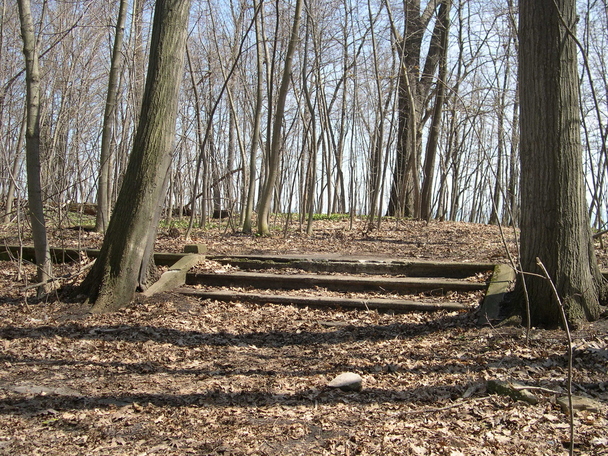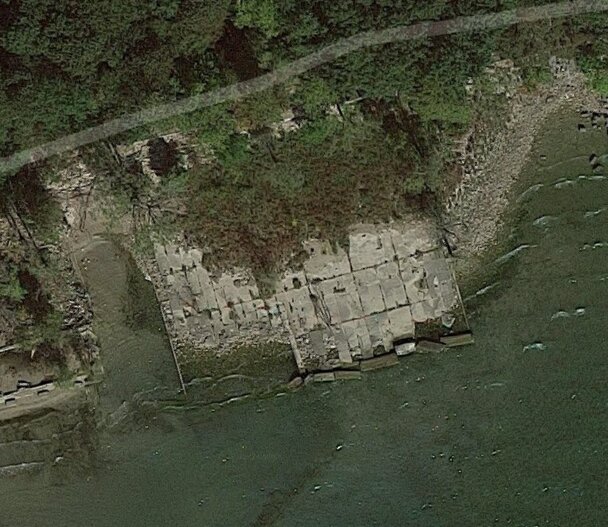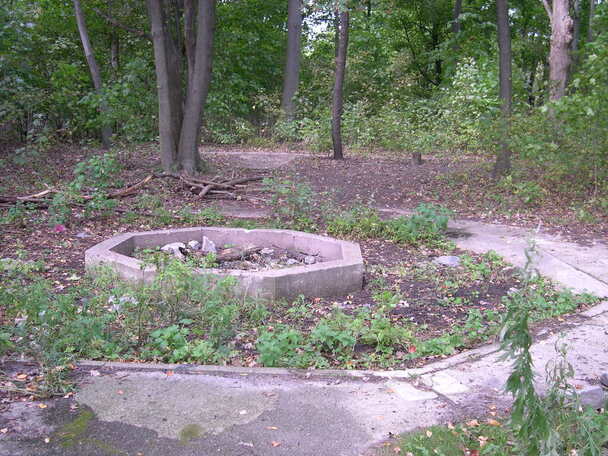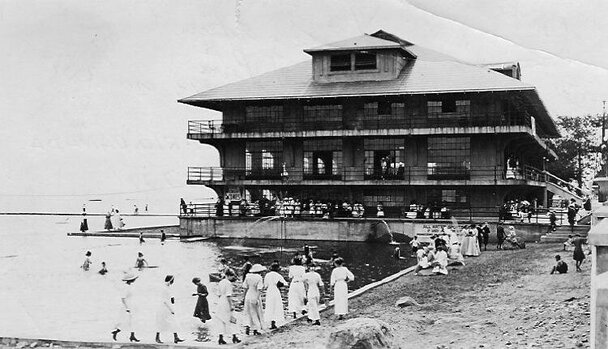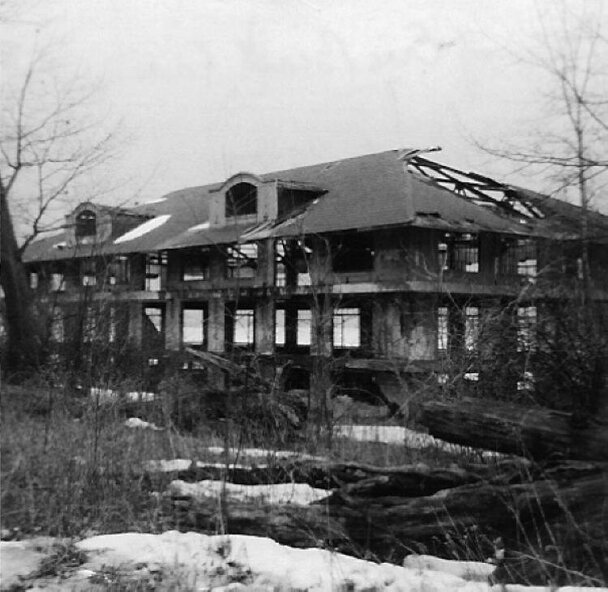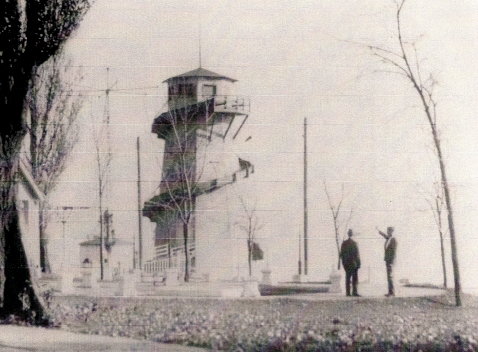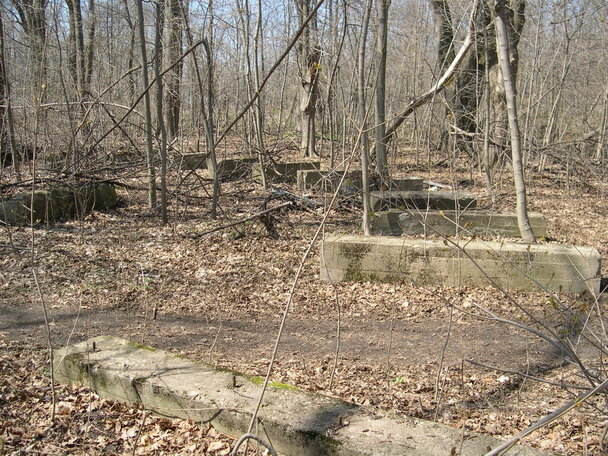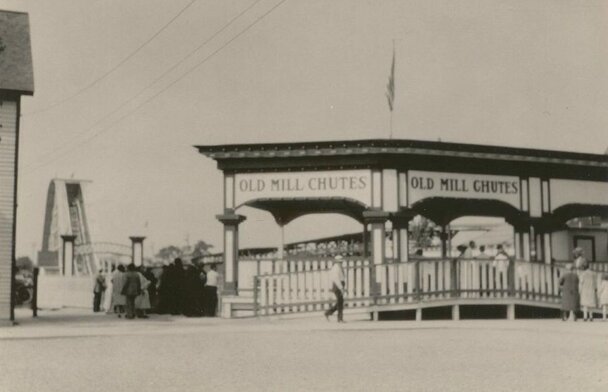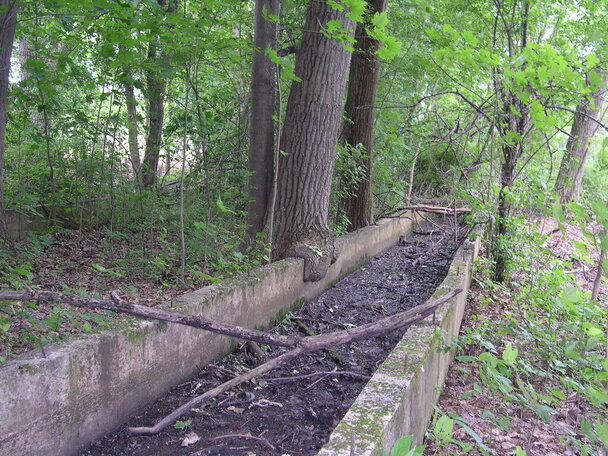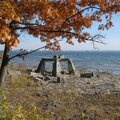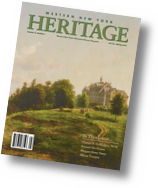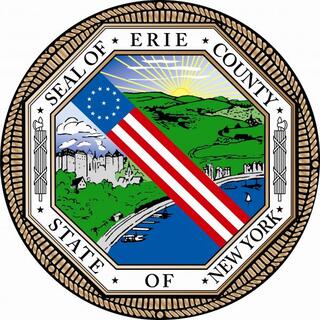The beginnings of Erie Beach Park and, later, amusement park were shared in our Spring 2022 issue, but we wanted to share more information about the remains of the park following its closure in 1930. So here is a web exclusive, touching on several of the rides and facilities, along with some of what remains today.
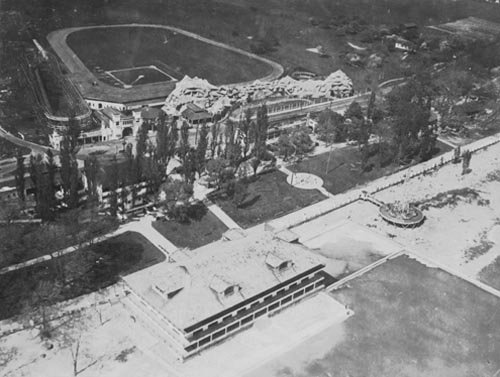
An aerial view of the Erie Beach Amusement Park, ca. late 1920s, showing the casino, airplane ride, stadium and site of the electric fountain.
Courtesy Ontario Archives.
The Pier
The remnants of the old pier, which was 1,000 feet long, can be seen extending out into the lake at the extreme eastern end of the public promenade. Here ferry boats docked, bringing passengers directly from Buffalo. Various ferries served the park over the years.
Light Posts
A few of the original concrete posts still exist along the start of the public promenade. They were topped with electric lamps and hanging flower baskets. A metal insert can be seen in the center of the posts where the wire would have been connected.
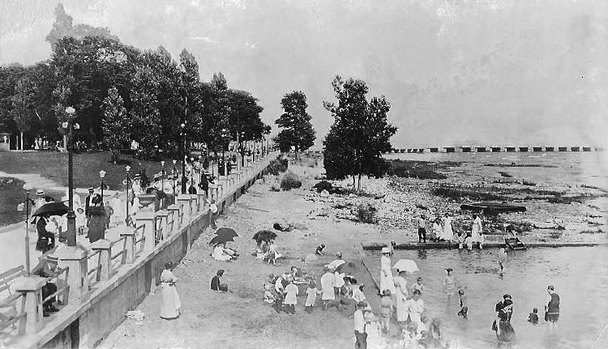
At left, along the promenade walk, are a series of posts that supported the electric lights illuminating the area. The pier is visible in the background.
Courtesy Niagara Falls (Ont.) Public Library
Train Station/Lunch Counter
A set of concrete steps lead up to the foundation of a building. These steps identify this building as a “Lunch Room” shown in an old photograph. The building however, is labelled as “Railway Station” on the 1910 map. The stubs of cement pillars existing at the top of the steps are visible in the lower photograph below. Since they serve no purpose for the snack bar, it would appear that the railway station was converted into a lunch counter. It is noteworthy that the map shows a “Restaurant” south of the station on the 2nd trail, but no remains are evident at this location. It has been reported that in 1911 the old restaurant was torn down and a modern dairy lunch built instead. This was likely the lunch room in the recycled railway station.
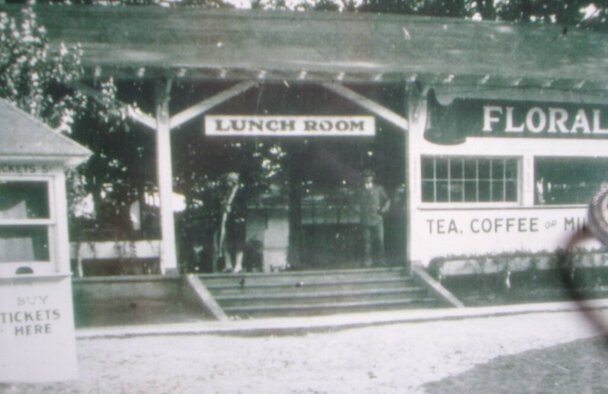
The entrance the lunch room, which replaced the Erie Beach Amusement Park train station, once the ferry began delivering visitors via the pier.
Private collection
Outdoor Pavilion
A large, paved area on the beach was a pavilion which had a bandstand by the lake and was ideal for large events, such as company parties.

The outdoor pavilion at Erie Beach Amusement Park. The band shelter is visible at right, with the pier in the background.
Courtesy Niagara Falls (Ont.) Public Library
Electric Fountain
The electric fountain was likely built in 1911. The circular base can be seen at the eastern end of the park just to the north of the public promenade. At the inner edge of the outside ring, the footprint of concrete posts can be discerned, and these posts are visible in old photos of the fountain.
Casino
The 3-story casino was built in 1910. It was not a gambling casino, but had a dance floor, fine restaurant and change rooms for 250 people. After the park closed, this building stood until the 1970s, when it was torn down, as the crumbling building posed a hazard. Only a pile of scattered remnants remain.
Swimming Pool
The large concrete swimming pool, located adjacent to what is now Waverly Beach, was probably built around 1920. It was billed as the largest outdoor pool in the world. Fresh water was pumped into the pool from the lake via the pump station which can be seen at the northeast corner. Fountain jets gushed up from piping at the bottom. The pool was divided into 2 sections for a deep and shallow end, with a 20-foot-wide wooden walkway and wire mesh to the bottom separating them. There was also a water slide and a lifeguard station.
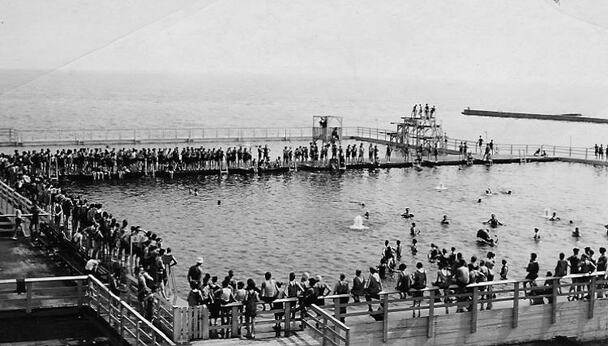
This view of the swimming pool shows the divider between the two segments.
Courtesy Niagara Falls (Ont.) Public Library
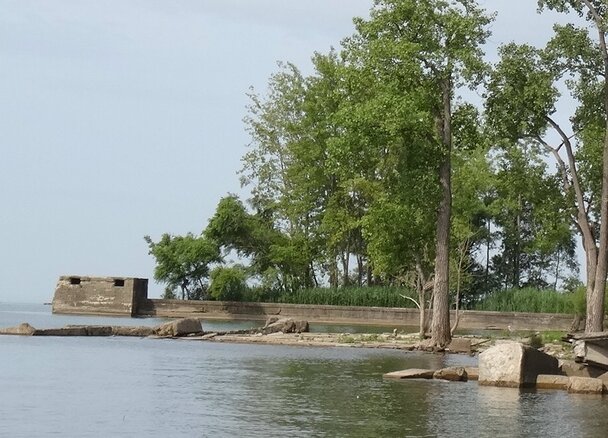
The concrete swimming pool wall and pump house are prominent landmarks along the Lake Erie shoreline today.
Author's photograph
Airplane Swing Ride
This strange looking group of cement columns that stood on the beach until destroyed in a storm in 2020 was the base for an amusement ride called the “Airplane Swing.” It had little planes suspended on cables that swung out in a circle from a metal structure atop a concrete base that rested on the pillars. There was the center pillar, four more pillars in the inner ring plus an outer ring of pillars. Another line of pillars supporting a ramp to walk out to the ride.
This ride was constructed sometime in the later years of the park. An earlier form of this ride, called the “Circle Swing”, was supported by a metal structure on the ground instead of concrete pillars. The ride was built by the Traver Engineering Company and was common in amusement parks of the period. A circa 1919 aerial photo shows the earlier ride located closer to the casino in the area where the outdoor pavilion was constructed. This ride appeared to have little gondola cars, and they were undoubtedly changed to airplanes in the new swing ride to accommodate the airplane craze associated with Charles Lindbergh in the 1920s.
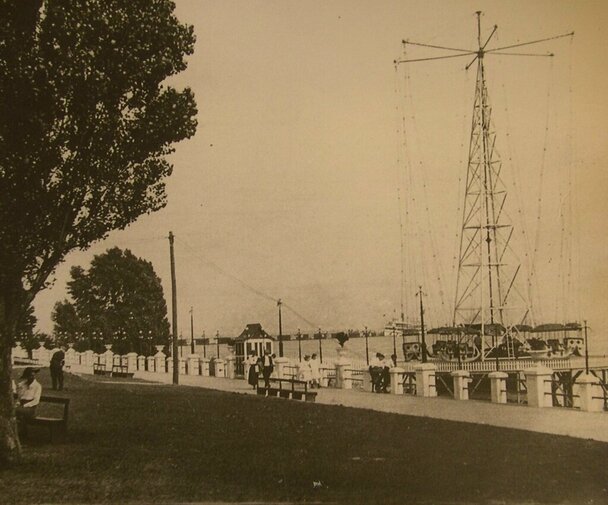
This view of the earlier swing ride shows the gondolas that held passengers.
Courtesy Fort Erie Public Library
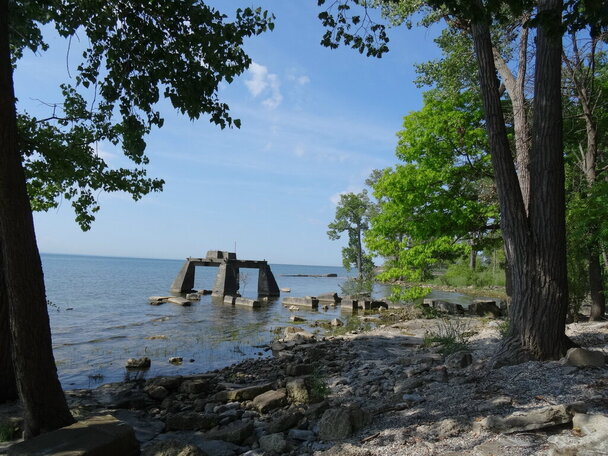
The concrete foundations for the later airplane ride stood for nearly 100 years before succumbing to a winter storm in November 2020.
Author's photograph
Slide Tower
The round cement circle seen on the beach is the base for the “Slide Tower” ride. This was also known as the “Helter Skelter” ride, an attraction that was common in old English fairgrounds. The four large cement pillars just in front of the promenade formed the base for a walkway from the promenade to the entrance into the tower.
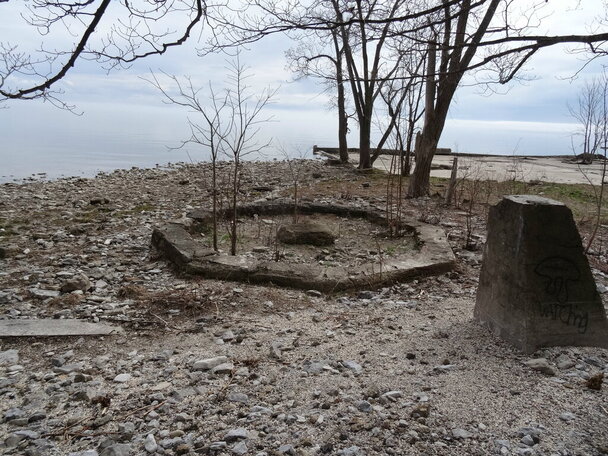
Today, the circular foundation of the slide ride is still visible along the lakeshore.
Author's photograph
Tumble Bug Ride
Located on the nature trail, which is an extension of Lakeshore Road, this remnant is a large circle of radiating concrete slabs, with the southerly portion of the circle obscured under the earth. This was an amusement known as the “Tumble Bug” ride. The diameter of the circle is 100 feet, which matches the recorded diameter of full-sized Tumble Bugs.
As of 2017, there were only two full sized operating Tumble Bug rides left in the world, at Kennywood Park and at Conneaut Lake Park, both in Pennsylvania. Both these rides were built by the Traver Engineering Company between 1925 and 1927, the same era as Erie Beach Amusement Park. Little bug shaped cars at the end of spokes ran round on a circular track. On the Erie Beach ruin, on the cement slabs are protruding metal rods and a faint indent mark down the center – this is where a metal bar was fastened that held the upright supports for the track. In the middle of the circle the large cement block held the motor works that turned the spokes.
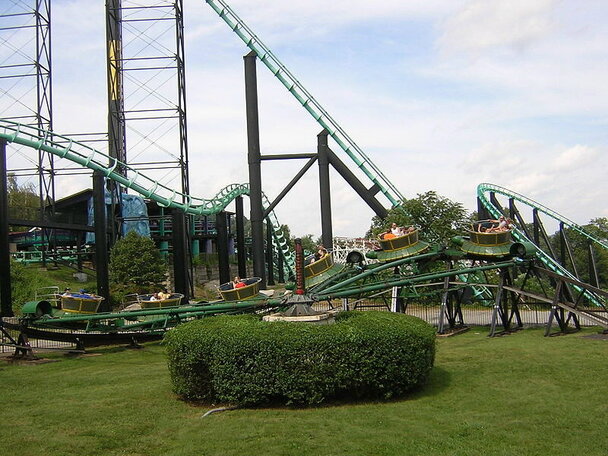
This Tumble Bug ride at Kennywood Park in Pennsylvania is one of only two still in existence. It dates from the same period as that built at Erie Beach.
Old Mill Chutes Ride
The Old Mill Chutes ride was a boat ride through a channel of water, which shot out down a cascade at the end. Located at the eastern side of the wood north of the third nature trail, it is shaped like a long hockey stick, and is comprised of concrete troughs with a wide circle at the front. The walls have metal rods embedded in them, where a metal structure would have been attached. The Mill Chutes ride was installed in the late 1920s. It is in the same location as the Scenic Railway roller coaster on the 1910 map. If you look at Google Earth 1934 imagery, you can clearly see the concrete troughs over the footprint of the roller coaster.
